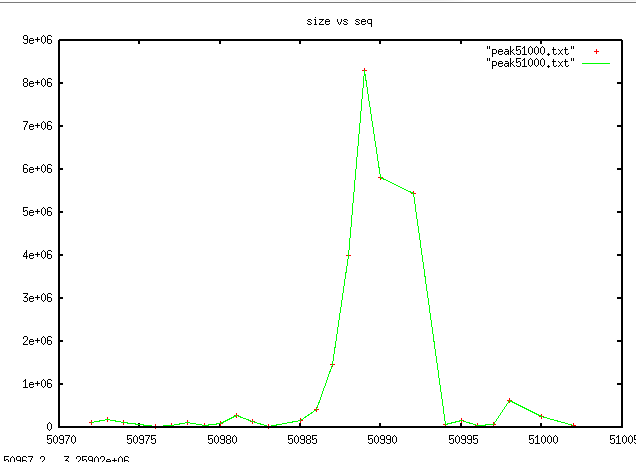Detailed Analysis of the effect of bunch cleaning for 27GeV events.
Starting in the 27GeV run we started to see abnormal charge steps in the tpc:
These steps are separated by 120 bunches, and are explained by having a large background associated with a single bunch. Each time the beam revolves through the machine there is extra background deposited into the TPC.
I downloaded a specific run worth of data, and sorted the events in strict order. The following plot shows the size of the event (which is a standin for the number of clusters in the TPC) vs the event number:
The event rate during this run was about 1000hz, so these spikes correspond to 1 second intervals. This suggests that the bunch cleaning (which attempts to knock beam out of the abort gaps once per second for about 2ms) is the source of the background.
If we zoom this plot in on a specific peak, we see that the background is found in approximately 6-7 events:

For the same peak, we see the bunch crossing (mod 120) for these events:
The important thing here, is that in the region of the peak (xaxis 50986 - 50993), the triggered bunch crossing is the same for all but one of the events. This implies again that this specific bunch crossing is causing background during this short period of time. Note that the actual bunch id here is arbitrary (I didn't apply the rev-tick offset), but I see from other plots that the location of bunch 57 is indeed in the yellow abort gap, further indication that the source is the bunch cleaning.
The bunch crossing is a measure of the time (107ns), so the slope of the bunch crossing vs event number gives the event rate. We see that during the period of the peak, the event rate also increases in a short burst. This burst lasts ~20,000 bunch crossings (about ~1.2ms), which is another indicator that the source is the bunch cleaning.
In the following plot I show the bunch crossing (mod 120) of the "Big Events" (Those with size > 1.1MB) for the 11am fill on May 14th . This size is chosen because very few if any standard 27GeV collisions produce events that large:
Here again, the actual bunch crossing from run to run is arbitrary. However, we clearly see that there is a strong band of BX that cause the large events, and then a weaker band. The stronger band is the Yellow abort gap, and the weaker is the Blue abort gap. This particular fill was one of the worst I've seen in this regard. Typically the events from the blue abort gap are nearly non-existent. There was some prior discussion about additional peaks outside of the abort gaps triggering large events. This is not true, these were based on taking the low 32 bits of the bunch crossing mod 120. However 2^32 is not divisible by 120, and so the modulus gave the incorrect later in the run.
So the final interpretation I have from all of this data is that the bunch cleaning turns on for 2ms every second in both beams. In the blue abort gap we don't see much effect, but in the yellow beam there is a specific bunch crossing which gets very high background for the full 2ms. This leads to a burst of triggers during this period triggering on this bunch crossing.
- jml's blog
- Login or register to post comments
